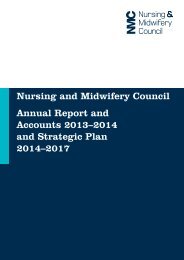Journal_1_2014_final_WEB
Journal_1_2014_final_WEB
Journal_1_2014_final_WEB
Create successful ePaper yourself
Turn your PDF publications into a flip-book with our unique Google optimized e-Paper software.
The biofilm challenge<br />
Maria Alhede,<br />
M.Sc., Ph.D<br />
Morten Alhede,<br />
M.Sc., Ph.D<br />
Biofilm Test Facility<br />
University of Copenhagen <br />
Department of International<br />
Health, Immunology<br />
and Microbiology <br />
Blegdamsvej 3B,<br />
Bldg. 24.1.22,<br />
DK-2200 Copenhagen<br />
Denmark<br />
http://biofilmtestfacility.<br />
ku.dk<br />
Correspondence:<br />
malhede@sund.ku.dk<br />
Conflict of interest: none<br />
Abstract<br />
The concept of biofilms has emerged in the<br />
clinical setting during the last decade. Infections<br />
involving biofilms have been documented in all<br />
parts of the human body, and it is currently believed<br />
that the presence of biofilm-forming bacteria<br />
is equivalent to chronic infection. A quick<br />
Pubmed search reveals the significance of biofilms,<br />
as evidenced by a dramatic increase in scientific<br />
publications on the topic, as well as in publications<br />
concerning wounds with biofilms, which<br />
reached 600 publications in 2013.<br />
Judged from the number of publications, it<br />
appears that biofilms play a significant role in<br />
wounds. However, the impact of biofilms is often<br />
debated, because infected wounds were also<br />
treated before the concept of biofilms was coined.<br />
In this short review, we will address the significance<br />
of biofilms and their role in wounds, and<br />
discuss the future tasks of the biofilm challenge.<br />
Biofilms in short<br />
Bacteria are found in at least two distinct states<br />
– planktonic and sessile cells. Planktonic cells are<br />
classically defined as “free flowing bacteria in suspension”<br />
as opposed to the sessile biofilm state,<br />
which is defined as “a structured community of<br />
bacterial cells enclosed in a self-produced polymeric<br />
matrix and adherent to an inert or living surface” 1 .<br />
Figure 1. Total biofilm publications on<br />
www.ncbi.nlm.nih.gov/pubmed/<br />
Until the last decade, microbiologists have focused<br />
and emphasized the planktonic state over the biofilm<br />
state. However, the importance of the biofilm<br />
mode of growth is becoming increasingly evident<br />
with the availability of improved methods to study<br />
sessile bacteria; hence the subsequent accumulation<br />
of evidence for its widespread presence 2,3 .<br />
Biofilms were discovered by one of the first<br />
microbiologists, the Dutch scientist Antoine van<br />
Leeuwenhoek, in the 1650s, but the actual breakthrough<br />
regarding this phenomenon occurred<br />
328 years later when Costerton and colleagues<br />
published their work on “How Bacteria Stick” in<br />
1978 4 . Since 1978, research on biofilm bacteria<br />
has exploded (Figure 1).<br />
It has now been established that most biofilmgrowing<br />
bacteria cause chronic infections 5 , which<br />
are characterized by persistent inflammation and<br />
tissue damage 6 . These chronic infections, including<br />
wound and foreign body infections, are<br />
infections that “1) persist in spite of antibiotic<br />
therapy and the innate and adaptive immune and<br />
inflammatory response of the host and 2) which,<br />
in contrast to colonization, are characterized by<br />
the immune response and persisting pathology” 7 .<br />
Traditionally, biofilms were considered as being attached<br />
to a surface. However, in situ hybridization<br />
(FISH) and confocal laser scanning microscopy<br />
(CLSM) of different infection sites have shown<br />
that the bacteria do not need to be attached to<br />
surfaces to establish a chronic infection. Instead,<br />
bacteria generate non-attached microcolonies by<br />
aggregating with their fellow bacteria through matrix<br />
components, and they appear to put up an<br />
impenetrable barrier to host immune cells (e.g.,<br />
phagocytic cells) 6,8-10 .<br />
The challenge faced with regard to biofilms in<br />
chronic infections lies in their significant tolerance<br />
to treatment with antibiotics and to the host’s<br />
immune response 11 . The antibiotic tolerance of<br />
the biofilm has been investigated in numerous in<br />
vitro models; these studies show that the biofilm<br />
can withstand treatment with very high dosages of<br />
antibiotics that are up to 1000 times the minimal<br />
inhibitory concentration 12 .<br />
54<br />
EWMA <strong>Journal</strong> <strong>2014</strong> vol 14 no 1




